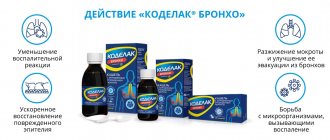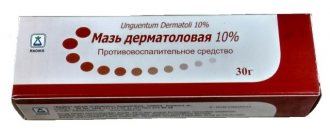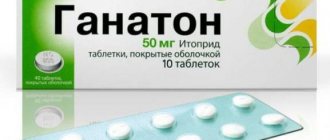Composition and release form
The drug is dispensed from the pharmacy in several dosage forms:
- Tablets have a thin soluble film coating.
- Suspension - mainly used for the treatment and prevention of children.
- Powder - represents small granules of a light shade. Used to prepare a solution.
All dosage forms are intended for oral administration. Packaged in cardboard packaging with attached instructions for use.
The active substance is nitrofurantoin. Its quantity varies depending on the form of release. Auxiliary components: calcium stearate, starch, silicon dioxide and more.
Contraindications for Furadonin
The following conditions are contraindications to taking an antimicrobial agent:
- Allergic reaction to the active or additional component.
- Severe heart failure.
- Liver cirrhosis.
- Chronic course of hepatitis.
- Serious liver disorders.
- Acute form of porphyria.
In addition, the drug is prohibited for use by children under 1 month of age and by women while pregnant and breastfeeding.
Along the beaten track
Judging by statistics, every second woman after the first episode of the disease develops a relapse within a year. And half of them have exacerbations more than 3 times a year. This happens because the initial treatment of acute cystitis was incorrect, and also because, when faced with a new case of the disease, many women, out of habit, take the medicine that helped them the last time. This is a huge mistake! The class of antibiotic must be changed, otherwise harmful bacteria, a small part of which could remain in the bladder, will develop resistance to the drug, and this will lead to the drug no longer working, and cystitis itself becoming chronic.
Therefore, a good doctor, before prescribing an antibacterial medicine, will definitely ask the patient how long ago and what kind of antibiotic he recently took.
BY THE WAY
In the West, cystitis is an inflammatory disease of the bladder and urethra. And in Russia, the disease is divided into cystitis and urethritis. In the first case we are talking about inflammation of the bladder, in the second – about inflammation of the urethra. And although these are details, we will adhere to the domestic view of the disease.
Side effects
The use of Furadonin may cause side effects such as:
- Disturbance of the digestive tract - nausea, vomiting, emaciation, pain in the epigastric region. Signs of hepatitis, jaundice and diarrhea are rarely observed.
- Dysfunction of the respiratory system - cough, chest discomfort, eosinophilia are observed, signs of asthma develop in people suffering from asthma attacks.
- Headache, dizziness, insomnia or drowsiness.
- Allergic reaction - skin rash, hyperemia, itching. Urticaria and angioedema are sometimes possible.
- Changes in laboratory blood values.
- Other manifestations include fever, myalgia, and arthralgia.
Doesn't tolerate delay
The symptoms of acute cystitis are known to everyone: pain in the lower abdomen, frequent painful urination, sometimes even blood in the urine. There are also severe pains that radiate to the anus or perineum. If, in such a situation, you immediately contact a therapist and quickly get tested to confirm the diagnosis, and then begin antibacterial treatment, then within a week you can forget about the disease.
If you delay visiting a doctor, then after 14 days acute cystitis will turn into a chronic form, which can occur with mild symptoms: that is, without severe pain and significant discomfort. And those minor ailments that may occur, many patients courageously endure. Sometimes - for years. Even establishing the correct diagnosis in this case is a big problem, and even more so getting cured. The danger is also that prolonged inflammation in chronic cystitis can eventually lead to cell degeneration and the development of bladder cancer. Therefore, you should go to the doctor as soon as you feel sick, and not sometime later, when there is a rush at work. Or when it gets easier.
Instructions for use of Furadonin
The medicine must be taken after meals with a sufficient amount of water. The tablets should not be chewed, but simply swallowed whole.
The therapeutic dosage of the drug per day is 0.3 g, maximum 0.6 g for adult patients. This dose is divided into 3-4 doses per day.
For the treatment of mild forms of the infectious process, it is indicated to use 50 mg three times a day.
In acute conditions, a course lasting 7-10 days is prescribed. If no therapeutic effect is observed after the end of the course, the drug is not extended.
To prevent exacerbations of pathological processes and prophylaxis, the medicine is taken in an amount of 1-2 mg/kg body weight.
For children, the therapeutic dose is calculated individually. Per 1 kg of weight there are 5-7 mg of the drug. The total amount is divided into 4 doses during the day.
To make treatment with an antimicrobial agent more effective, it is necessary to consume more protein foods during the course.
Furadonin-Avexima tablets 50 mg No. 20
Compound
1 tablet: nitrofurantoin 50 mg excipients: potato starch, aerosil, calcium stearate.
Pharmacokinetics
Pharmaceutical group: antimicrobial agent - nitrofuran. Pharmaceutical action: Synthetic broad-spectrum antimicrobial agent. Acts bactericidal. The mechanism of action is associated with the restoration of furadonin into an active intermediate that damages ribosomal proteins and disrupts the synthesis of protein, DNA, and RNA. In high doses, it disrupts the permeability of the bacterial cell membrane. Active against gram-positive aerobic bacteria: Staphylococcus spp., Streptococcus spp., gram-negative aerobic bacteria: Escherichia coli, Enterobacter spp., Klebsiella spp., Shigella spp. Weakly active against Enterococcus spp., fungi of the genus Candida. Not active against Pseudomonas aeruginosa, Acinetobacter spp. Most strains of Proteus and Serratia are resistant to furadonin.
Indications for use
Bacterial infections of the urinary tract (pyelitis, pyelonephritis, urethritis, cystitis), prevention of infections during urological operations or examinations (cystoscopy, catheterization, etc.).
Contraindications
- hypersensitivity to nitrofurantoin or nitrofurans, - severe renal dysfunction, renal failure, oliguria (creatine clearance less than 60 ml/min), - children under 6 years of age, - liver cirrhosis, chronic hepatitis, - chronic heart failure (III-IV NYHA class), - glucose-6-phosphate dehydrogenase deficiency, - acute porphyria. - pregnancy and lactation due to possible hemolytic anemia in the fetus or newborn due to the immaturity of erythrocyte enzyme systems.
Directions for use and doses
Take orally, during meals, with plenty of water. Adult patients: Acute uncomplicated urinary tract infections: 50 mg four times daily for seven days. Severe recurrent infection: 100 mg four times daily for seven days. Long-term maintenance therapy: 50-100 mg once daily. Prevention: 50 mg four times a day for urological operations and examinations and 3 days after them. Children over 6 years of age: Acute uncomplicated urinary tract infections: 3 mg/kg/day in four divided doses for seven days. Maintenance therapy: 1 mg/kg once daily. For children weighing less than 25 kg, it is recommended to use the drug in the form of a suspension.
Storage conditions
Store in a dry place, protected from light, at a temperature not exceeding 25 C. Keep out of the reach of children.
Best before date
4 years.
special instructions
The drug should be discontinued at the first signs of peripheral neuropathy (paresthesia), because the development of this complication can be life-threatening. It is necessary to stop treatment with furadonin if unexplained symptoms of impaired pulmonary function, liver function, hematological and neurological disorders occur. If signs of lung damage appear, furadonin should be stopped immediately. Careful monitoring of pulmonary function is required in patients receiving long-term treatment with furadonin, especially in the elderly. Careful monitoring of patients receiving long-term therapy with furadonin is necessary to identify signs of hepatitis development. After taking furadonin, the urine may turn yellow or brown. Patients receiving furadonin may experience false-positive reactions when determining glucose in the urine. Furadonin should be discontinued if signs of hemolysis appear in patients with suspected glucose-6-phosphate dehydrogenase deficiency. Reactions from the gastrointestinal tract can be minimized when taking the drug with food, milk or by reducing the dose. Pregnancy and lactation period. The use of furadonin during pregnancy is contraindicated. If it is necessary to use it during lactation, the child should be weaned from the breast for the entire period of treatment. Use in pediatrics. Not recommended for use in children under 6 years of age. Caution when prescribing should be observed in persons with diabetes mellitus, anemia, electrolyte disturbances, deficiency of B vitamins, because the neurotoxic effect of the drug may be enhanced. Furadonin should not be used to treat diseases of the renal cortex (glomerulonephritis), purulent paranephritis, or prostatitis. Especially for the treatment of parenchymal infection of one non-functioning kidney. In cases of recurrent or severe infection, surgical causes must be excluded.
Pharmacodynamics
Absorption from the gastrointestinal tract is good. Bioavailability 50% (food increases bioavailability). The rate of absorption depends on the size of the crystals (the microcrystalline form is characterized by rapid solubility and absorption rate, short time to reach maximum concentration in urine). Connection with plasma proteins 60%. Metabolized in the liver and muscle tissue. The half-life is 20-25 minutes. Penetrates the placenta, blood-brain barrier, and is excreted in breast milk. It is excreted completely by the kidneys (30-50% unchanged).
Side effects
- nausea, vomiting, abdominal pain, diarrhea, hepatitis, cholestatic syndrome, pancreatitis, pseudomembranous enterocolitis. - dizziness, headache, asthenia, nystagmus, drowsiness, peripheral neuropathy. - interstitial changes in the lungs (interstitial pneumonitis, pulmonary fibrosis), bronchospasm, cough, flu-like syndrome, chest pain. - leukopenia, granulocytopenia, agranulocytosis, thrombocytopenia, hemolytic anemia, megaloblastic anemia. - lupus-like syndrome, arthralgia, myalgia, anaphylactic reactions, fever, eosinophilia, rash, exudative erythema multiforme (Stevens-Johnson syndrome), exfoliative dermatitis. - superinfection of the genitourinary tract, most often caused by Pseudomonas aeruginosa.
Use during pregnancy and breastfeeding
The use of the drug during pregnancy and breastfeeding is contraindicated.
Interaction
The absorption of furadonin is increased when taken with food or with medications that cause delayed gastric emptying. Magnesium trisilicate reduces the absorption of furadonin. Probenecid and sulfinpyrazone reduce the renal excretion of furadonin. Corboanhydrase inhibitors and agents that cause an alkaline reaction in urine reduce the antibacterial activity of furadonin. Furadonin and antimicrobial agents from the fluoroquinolone group are antibacterial antagonists. Furadonin can suppress intestinal flora, which leads to a decrease in estrogen absorption and the effectiveness of estrogen-containing contraceptives. Patients are recommended to use non-hormonal methods of contraception. Furadonin may inactivate the oral typhoid vaccine. Nitrofurantoin weakens the antibacterial effect of norfloxacin in the urinary tract; simultaneous use is not recommended.
Overdose
Symptoms: when high doses are administered, dizziness, nausea, and vomiting may occur. Treatment: discontinuation of the drug, taking large amounts of fluid to increase urinary excretion of the drug, hemodialysis, symptomatic therapy. There is no specific antidote.
Impact on the ability to drive vehicles and operate machinery
Furadonin may cause dizziness and drowsiness. The patient should not drive a car or operate moving machinery while taking the medicine.
Interaction with other drugs
It is prohibited to take the medicine together with fluoroquinolones.
The antimicrobial effect of the drug is reduced when taken simultaneously with antacid medications containing magnesium trisilicate and nalidixic acid.
Drugs that block tubular secretion also lead to a decrease in the pharmacological effect. They, with increasing concentrations of nitrofurantoin, can increase the toxicity of the drug.
The therapeutic effect of the antimicrobial drug is suppressed in alkaline urine. Therefore, it is forbidden to combine the medicine with other drugs that increase the pH of urine.
It is not recommended to combine Furadonin with Probenecid and Sulfinpyrazone, as they inhibit the process of drug elimination.
Profitable loyalty
There is an objective anatomical reason for the fact that cystitis is predominantly female. After all, in the fair sex, the urethra is much shorter and wider than the male one, so the path upward to the bladder for pathogenic microbes becomes shorter and easier. However, for a disease to occur, the penetration of microbial agents alone is not enough. After all, the protective forces of the bladder mucosa, guarded by beneficial lacto- and bifidobacteria, are usually sufficient to give a worthy rebuff to the infection. But if local immunity is weakened, then it’s a different matter. The protective forces of the mucous membrane can be negatively affected, for example, by hypothermia, injury, stress, excessive alcohol intake, promiscuous sex life, poor intimate hygiene, chronic diseases, etc.
By the way, frequent changes of sexual partners for women (and especially young girls with unsettled hormonal levels and not fully formed intimate microflora) are even more harmful than for men. And we’re not just talking about sexually transmitted diseases. After all, the female intimate flora is forced to adapt to the partner’s flora each time (after all, men’s intimate organs normally contain streptococci and other opportunistic flora). At some point, the adaptation process may be disrupted, and then the female microflora will suffer, and against this background, candidiasis, cystitis, and other troubles may arise. Therefore, it is especially important for girls to remain faithful to their only sexual partners, and it is better for very young ladies not to rush into “adult” life.








